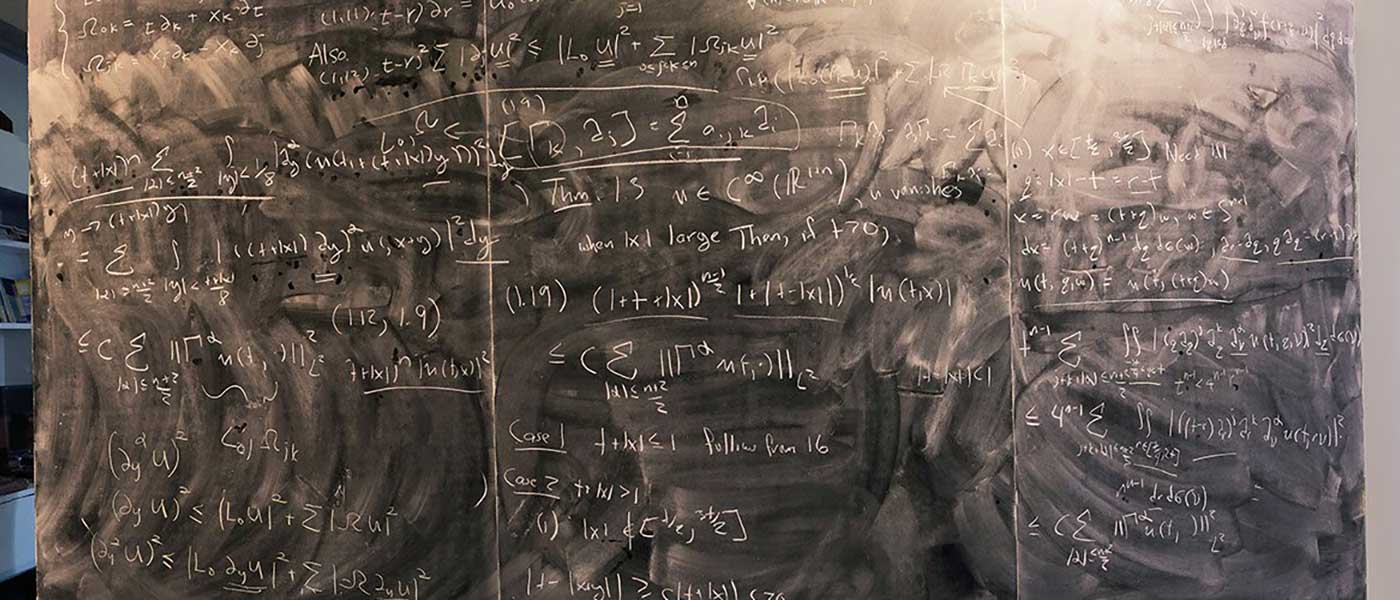Analysis
Analysis is the study of functions, continuity and discontinuity, the infinite and the infinitesimal. At McMaster research in analysis deals with Harmonic Analysis and Partial Differential Equations. Harmonic analysis traces its roots back to Fourier series and is key for image segmentation, pattern recognition, and data compression. Current research involves oscillatory integrals, moment problems, and wavelets. Research in Partial Differential Equations includes fully nonlinear equations, free boundary problems, geometrical PDEs, degenerate elliptic and parabolic systems, and small divisor problems.
Information Box Group
Stanley Alama
Emeritus Professor
Research Area: Analysis, applied-mathematics
Research Profile: Nonlinear partial differential equations, mathematical physics.
I work in the areas of elliptic partial differential equations, the calculus of variations, and mathematical physics. Elliptic PDEs often arise as stationary equilibria in physical problems or in describing curved surfaces in differential geometry. The calculus of variations is concerned with extrema (critical points) of functions defined on infinite dimensional spaces. For example, solutions to the Dirichlet problem minimize an associated integral among all functions with the given boundary data (“Dirichlet’s Principle”). This observation, known to Gauss and Riemann, introduced variational methods as a tool in studying elliptic PDEs. Today we use a combination of classical variational techniques, real and functional analysis, and topology to study existence, multiplicity, smoothness, stability, and other qualitative properties of solutions to PDEs. Of particular interest are those problems (arising in physics and geometry) where minimizing sequences may not converge, due to the natural symmetries of the problem.
Blaise Bourdin
Professor, Canada Research Chair
Lia Bronsard
Professor
Research Area: Analysis, applied-mathematics
Research Profile:Nonlinear partial differential equations, interface dynamics.
Interface dynamics is a study of the qualitative behaviour of solutions to certain nonlinear partial differential equations known as singular reaction-diffusion systems. These systems are usually models developed by material scientists and mathematicians in order to understand the properties of interfaces or phase boundaries in alloys, polymers or glasses. Under stress, the alloy divides into several regions where the orientation of the molecules differs. The boundary between these regions evolve in time in order to decrease surface tension. The mathematical models developed to study this evolution lead to geometrical problems for the interfaces. An important example is mean curvature evolution, where the normal velocity of the interface is given by its mean curvature. A formal asymptotic tool called the method of matched asymptotic expansion is often used to predict the behaviour for the evolution of the interfaces. Once this formal study is done, the problem is then to develop analytical and geometrical tools to verify rigorously the expected behaviour. Since the models involve nonlinear partial differential equations, new tools are often needed to successfully complete the work.
Eric T. Sawyer
McKay Chair in Mathematics, Professor
Research Area: Analysis
Research Profile: Harmonic analysis, partial differential equations and function theory
Harmonic analysis, partial differential equations and function theory My research interests in harmonic analysis center on weighted norm inequalities for fractional and singular integrals, with applications to problems in partial differential equations such as regularity of solutions to the oblique derivative problem, sharp estimates for the eigenvalues of Schrodinger operators, regularity for the Monge-Ampere equation and distortion of Hausdorff measure under quasiconformal maps. My interests in function theory include interpolation and corona problems on the unit ball in several complex variables.
Stanley Alama
Emeritus Professor
Research Area: Analysis, applied-mathematics
Research Profile: Nonlinear partial differential equations, mathematical physics.
I work in the areas of elliptic partial differential equations, the calculus of variations, and mathematical physics. Elliptic PDEs often arise as stationary equilibria in physical problems or in describing curved surfaces in differential geometry. The calculus of variations is concerned with extrema (critical points) of functions defined on infinite dimensional spaces. For example, solutions to the Dirichlet problem minimize an associated integral among all functions with the given boundary data (“Dirichlet’s Principle”). This observation, known to Gauss and Riemann, introduced variational methods as a tool in studying elliptic PDEs. Today we use a combination of classical variational techniques, real and functional analysis, and topology to study existence, multiplicity, smoothness, stability, and other qualitative properties of solutions to PDEs. Of particular interest are those problems (arising in physics and geometry) where minimizing sequences may not converge, due to the natural symmetries of the problem.
Stanley Alama
Emeritus Professor
Research Area: Analysis, applied-mathematics
Research Profile: Nonlinear partial differential equations, mathematical physics.
I work in the areas of elliptic partial differential equations, the calculus of variations, and mathematical physics. Elliptic PDEs often arise as stationary equilibria in physical problems or in describing curved surfaces in differential geometry. The calculus of variations is concerned with extrema (critical points) of functions defined on infinite dimensional spaces. For example, solutions to the Dirichlet problem minimize an associated integral among all functions with the given boundary data (“Dirichlet’s Principle”). This observation, known to Gauss and Riemann, introduced variational methods as a tool in studying elliptic PDEs. Today we use a combination of classical variational techniques, real and functional analysis, and topology to study existence, multiplicity, smoothness, stability, and other qualitative properties of solutions to PDEs. Of particular interest are those problems (arising in physics and geometry) where minimizing sequences may not converge, due to the natural symmetries of the problem.
Blaise Bourdin
Professor, Canada Research Chair
Blaise Bourdin
Professor, Canada Research Chair
Lia Bronsard
Professor
Research Area: Analysis, applied-mathematics
Research Profile:Nonlinear partial differential equations, interface dynamics.
Interface dynamics is a study of the qualitative behaviour of solutions to certain nonlinear partial differential equations known as singular reaction-diffusion systems. These systems are usually models developed by material scientists and mathematicians in order to understand the properties of interfaces or phase boundaries in alloys, polymers or glasses. Under stress, the alloy divides into several regions where the orientation of the molecules differs. The boundary between these regions evolve in time in order to decrease surface tension. The mathematical models developed to study this evolution lead to geometrical problems for the interfaces. An important example is mean curvature evolution, where the normal velocity of the interface is given by its mean curvature. A formal asymptotic tool called the method of matched asymptotic expansion is often used to predict the behaviour for the evolution of the interfaces. Once this formal study is done, the problem is then to develop analytical and geometrical tools to verify rigorously the expected behaviour. Since the models involve nonlinear partial differential equations, new tools are often needed to successfully complete the work.
Lia Bronsard
Professor
Research Area: Analysis, applied-mathematics
Research Profile:Nonlinear partial differential equations, interface dynamics.
Interface dynamics is a study of the qualitative behaviour of solutions to certain nonlinear partial differential equations known as singular reaction-diffusion systems. These systems are usually models developed by material scientists and mathematicians in order to understand the properties of interfaces or phase boundaries in alloys, polymers or glasses. Under stress, the alloy divides into several regions where the orientation of the molecules differs. The boundary between these regions evolve in time in order to decrease surface tension. The mathematical models developed to study this evolution lead to geometrical problems for the interfaces. An important example is mean curvature evolution, where the normal velocity of the interface is given by its mean curvature. A formal asymptotic tool called the method of matched asymptotic expansion is often used to predict the behaviour for the evolution of the interfaces. Once this formal study is done, the problem is then to develop analytical and geometrical tools to verify rigorously the expected behaviour. Since the models involve nonlinear partial differential equations, new tools are often needed to successfully complete the work.
Eric T. Sawyer
McKay Chair in Mathematics, Professor
Research Area: Analysis
Research Profile: Harmonic analysis, partial differential equations and function theory
Harmonic analysis, partial differential equations and function theory My research interests in harmonic analysis center on weighted norm inequalities for fractional and singular integrals, with applications to problems in partial differential equations such as regularity of solutions to the oblique derivative problem, sharp estimates for the eigenvalues of Schrodinger operators, regularity for the Monge-Ampere equation and distortion of Hausdorff measure under quasiconformal maps. My interests in function theory include interpolation and corona problems on the unit ball in several complex variables.
Eric T. Sawyer
McKay Chair in Mathematics, Professor
Research Area: Analysis
Research Profile: Harmonic analysis, partial differential equations and function theory
Harmonic analysis, partial differential equations and function theory My research interests in harmonic analysis center on weighted norm inequalities for fractional and singular integrals, with applications to problems in partial differential equations such as regularity of solutions to the oblique derivative problem, sharp estimates for the eigenvalues of Schrodinger operators, regularity for the Monge-Ampere equation and distortion of Hausdorff measure under quasiconformal maps. My interests in function theory include interpolation and corona problems on the unit ball in several complex variables.





